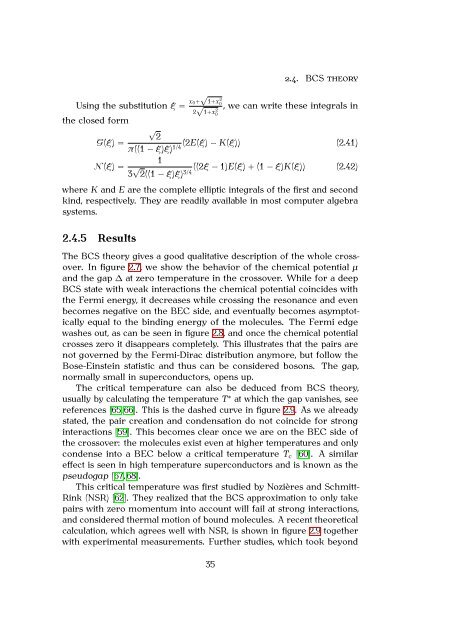Martin Teichmann Atomes de lithium-6 ultra froids dans la ... - TEL
Martin Teichmann Atomes de lithium-6 ultra froids dans la ... - TEL
Martin Teichmann Atomes de lithium-6 ultra froids dans la ... - TEL
Create successful ePaper yourself
Turn your PDF publications into a flip-book with our unique Google optimized e-Paper software.
2.4. BCS THEORY<br />
Using the substitution ξ = x0+<br />
√<br />
2 1+x0 √ , we can write these integrals in<br />
2 2 1+x0 the closed form<br />
√<br />
2<br />
G(ξ) =<br />
(2E(ξ) − K(ξ)) (2.41)<br />
π((1 − ξ)ξ) 1/4<br />
1<br />
N(ξ) =<br />
3 √ ((2ξ − 1)E(ξ) + (1 − ξ)K(ξ)) (2.42)<br />
2((1 − ξ)ξ) 3/4<br />
where K and E are the complete elliptic integrals of the first and second<br />
kind, respectively. They are readily avai<strong>la</strong>ble in most computer algebra<br />
systems.<br />
2.4.5 Results<br />
The BCS theory gives a good qualitative <strong>de</strong>scription of the whole crossover.<br />
In figure 2.7, we show the behavior of the chemical potential µ<br />
and the gap ∆ at zero temperature in the crossover. While for a <strong>de</strong>ep<br />
BCS state with weak interactions the chemical potential coinci<strong>de</strong>s with<br />
the Fermi energy, it <strong>de</strong>creases while crossing the resonance and even<br />
becomes negative on the BEC si<strong>de</strong>, and eventually becomes asymptotically<br />
equal to the binding energy of the molecules. The Fermi edge<br />
washes out, as can be seen in figure 2.8, and once the chemical potential<br />
crosses zero it disappears completely. This illustrates that the pairs are<br />
not governed by the Fermi-Dirac distribution anymore, but follow the<br />
Bose-Einstein statistic and thus can be consi<strong>de</strong>red bosons. The gap,<br />
normally small in superconductors, opens up.<br />
The critical temperature can also be <strong>de</strong>duced from BCS theory,<br />
usually by calcu<strong>la</strong>ting the temperature T ∗ at which the gap vanishes, see<br />
references [65, 66]. This is the dashed curve in figure 2.9. As we already<br />
stated, the pair creation and con<strong>de</strong>nsation do not coinci<strong>de</strong> for strong<br />
interactions [59]. This becomes clear once we are on the BEC si<strong>de</strong> of<br />
the crossover: the molecules exist even at higher temperatures and only<br />
con<strong>de</strong>nse into a BEC below a critical temperature Tc [60]. A simi<strong>la</strong>r<br />
effect is seen in high temperature superconductors and is known as the<br />
pseudogap [67, 68].<br />
This critical temperature was first studied by Nozières and Schmitt-<br />
Rink (NSR) [62]. They realized that the BCS approximation to only take<br />
pairs with zero momentum into account will fail at strong interactions,<br />
and consi<strong>de</strong>red thermal motion of bound molecules. A recent theoretical<br />
calcu<strong>la</strong>tion, which agrees well with NSR, is shown in figure 2.9 together<br />
with experimental measurements. Further studies, which took beyond<br />
35

















